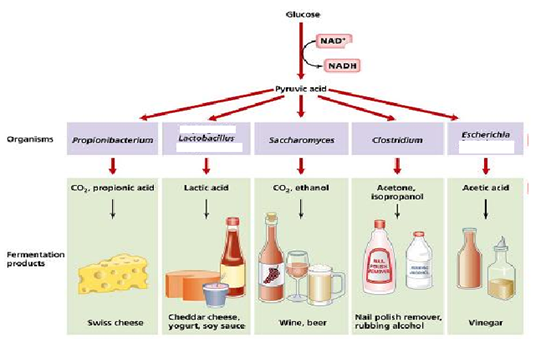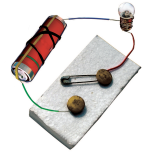12th Grade > Biology
MICROBES IN HUMAN WELFARE MCQs
Total Questions : 51
| Page 3 of 6 pages
Answer: Option A. -> Converting gaseous nitrogen to ammonia
:
A
Rhizobium converts nitrogen to ammonia, Nitrosomonas converts the ammonia to nitrite, whereas Nitrobacter converts the same ammonia to nitrate. It is easiest for plants to take up nitrogen in the form of nitrates as apposed to gaseous nitrogen.
:
A
Rhizobium converts nitrogen to ammonia, Nitrosomonas converts the ammonia to nitrite, whereas Nitrobacter converts the same ammonia to nitrate. It is easiest for plants to take up nitrogen in the form of nitrates as apposed to gaseous nitrogen.
Answer: Option A. -> Human waste
:
A
In biological treatment of sewage water, microbial flocs (group of aerobic bacteria associated with fungi forming a mesh like network) are used in treatment of partially treated effluent in aeration tanks. Aeration of wastewater facilitates the growth of aerobic bacteria which can degrade the solubilised and suspended organic matter in sewage water. Hence they specifically act on organic wastes like human wastes, animal wastes, kitchen wastes etc,
:
A
In biological treatment of sewage water, microbial flocs (group of aerobic bacteria associated with fungi forming a mesh like network) are used in treatment of partially treated effluent in aeration tanks. Aeration of wastewater facilitates the growth of aerobic bacteria which can degrade the solubilised and suspended organic matter in sewage water. Hence they specifically act on organic wastes like human wastes, animal wastes, kitchen wastes etc,
Answer: Option B. -> Biological process that is used to remove dissolved and suspended organic compounds
:
B
Secondary sewage treatment is a biological process that is used in theremoval of suspended and dissolved organic compounds from the sewage water by using microbial flocs (Group of anaerobic bacteria that are associated with fungal filaments to form mesh-like structures). It aims toachieve a certain degree ofeffluentquality by using asewage treatmentplant with primary treatment for separation of removable (large) and settleable (small) solids followed by biological process to remove dissolved and suspended organic compounds. These flocs greatly aid in the reduction of BOD of water so that it can be disposed safely without polluting water bodies.
:
B
Secondary sewage treatment is a biological process that is used in theremoval of suspended and dissolved organic compounds from the sewage water by using microbial flocs (Group of anaerobic bacteria that are associated with fungal filaments to form mesh-like structures). It aims toachieve a certain degree ofeffluentquality by using asewage treatmentplant with primary treatment for separation of removable (large) and settleable (small) solids followed by biological process to remove dissolved and suspended organic compounds. These flocs greatly aid in the reduction of BOD of water so that it can be disposed safely without polluting water bodies.
Answer: Option B. -> symbiotic
:
B
Mycorrhiza is an association of a fungus which grows in the roots of a plant in a symbiotic relationship with the plant. The relationship between the fungus and root exists because the fungi absorb phosphorus from the soil and pass it to the plant and inturn, the fungi get a safe environment for their survival. In most cases, fungi can be both saprophytic and parasitic in nature where they only work for self benefit. But in mutualistic and symbiotic associations the fungal partner and the other partner, in this case the plant, gain equal benefits from their interactions with each other.
:
B
Mycorrhiza is an association of a fungus which grows in the roots of a plant in a symbiotic relationship with the plant. The relationship between the fungus and root exists because the fungi absorb phosphorus from the soil and pass it to the plant and inturn, the fungi get a safe environment for their survival. In most cases, fungi can be both saprophytic and parasitic in nature where they only work for self benefit. But in mutualistic and symbiotic associations the fungal partner and the other partner, in this case the plant, gain equal benefits from their interactions with each other.
Answer: Option B. -> Both A and R are correct and R is not the right explanation for A.
:
B
Antibioticsare medicines produced by fungi and bacteria to ward off other bacteria in the wild. For example, penicillin is produced from the fungus called Penicillium, and streptomycin is obtained from a bacterium called Streptomyces griseus. Antibiotics specifically target the bacteria's ability to divide by attacking a specific bacterial component. Thus treatment with antibiotics prevents specific bacteria from proliferating. Viruses have different mechanisms and machinery to survive and replicate in human body. Theantibiotichas no “target” to attack in avirus. Although both the assertion and reason are true, they hold true independent of each other. The reason does not explain the assertion.
:
B
Antibioticsare medicines produced by fungi and bacteria to ward off other bacteria in the wild. For example, penicillin is produced from the fungus called Penicillium, and streptomycin is obtained from a bacterium called Streptomyces griseus. Antibiotics specifically target the bacteria's ability to divide by attacking a specific bacterial component. Thus treatment with antibiotics prevents specific bacteria from proliferating. Viruses have different mechanisms and machinery to survive and replicate in human body. Theantibiotichas no “target” to attack in avirus. Although both the assertion and reason are true, they hold true independent of each other. The reason does not explain the assertion.
Answer: Option B. -> False
:
B
Bt-cotton has the gene of a toxin of the bacterium Bacillus thuringiensis genetically engineered in it. This toxin when ingested by larvae of insects brings about their death. It is not effective against fungal diseases.
:
B
Bt-cotton has the gene of a toxin of the bacterium Bacillus thuringiensis genetically engineered in it. This toxin when ingested by larvae of insects brings about their death. It is not effective against fungal diseases.
Answer: Option D. -> Streptokinase
:
D
Streptokinase is a protein produced by the bacterium Streptococcus that enhances the action of a human protein that clears blood clots. Since myocardial infarction or heart attack results from arterial blockage caused by blood clots, streptokinase produced by E. coli is used to clear the clot and treat the disease. Cyclosporin A and statins are antibiotics which are used as specific therapeutic agents. Cyclosporin A produced by the fungus Trichoderma polysporum, is used as an immunosuppressive agent. Statins are produced by fungi that inhibit the production of cholesterol. Penicillin produced by Penicillium fungal species is an antiobiotic used to treatinfectionscaused by bacteria such as pneumonia,scarlet fever, ear, skin, and throatinfections.
:
D
Streptokinase is a protein produced by the bacterium Streptococcus that enhances the action of a human protein that clears blood clots. Since myocardial infarction or heart attack results from arterial blockage caused by blood clots, streptokinase produced by E. coli is used to clear the clot and treat the disease. Cyclosporin A and statins are antibiotics which are used as specific therapeutic agents. Cyclosporin A produced by the fungus Trichoderma polysporum, is used as an immunosuppressive agent. Statins are produced by fungi that inhibit the production of cholesterol. Penicillin produced by Penicillium fungal species is an antiobiotic used to treatinfectionscaused by bacteria such as pneumonia,scarlet fever, ear, skin, and throatinfections.
Answer: Option B. -> Penicillium
:
B
Fungi are used in cheese making.Fungi usually produce toxins that are harmful for consumption. But,not only is Blue cheese safe for our consumption but also healthy. This is because, Penicillium roqueforti and Penicillium glaucum which are the moulds used for Bluecheese, cannot produce these toxins in cheese. The combination of acidity, salinity, moisture, density, temperature and oxygen flow, creates an environment that is far outside thetoxin production range for these moulds.
:
B
Fungi are used in cheese making.Fungi usually produce toxins that are harmful for consumption. But,not only is Blue cheese safe for our consumption but also healthy. This is because, Penicillium roqueforti and Penicillium glaucum which are the moulds used for Bluecheese, cannot produce these toxins in cheese. The combination of acidity, salinity, moisture, density, temperature and oxygen flow, creates an environment that is far outside thetoxin production range for these moulds.
Answer: Option A. -> primary treatment
:
A
Primary treatment is the first treatment of sewage water where the small solid particles are removed by sedimentation and the large particles re removed by filteration process.The sewage in this step is split into solid and liquid components. This is achieved by sedimentation and by filtration. Sedimentation describes the passive process by which small solid particles are separated from the liquid water by gravitational forces. When the sewage is left standing, the solid content will eventually fall to the bottom, while the liquid portion will stay at the top. The separation of solids and liquids can be furthered by active filtration processes, in which sewage is passed through a porous material to remove large particles. The liquid post primary treatment is ready for secondary treatment with helpful bacteria that breakdown organic matter present in sewage.
:
A
Primary treatment is the first treatment of sewage water where the small solid particles are removed by sedimentation and the large particles re removed by filteration process.The sewage in this step is split into solid and liquid components. This is achieved by sedimentation and by filtration. Sedimentation describes the passive process by which small solid particles are separated from the liquid water by gravitational forces. When the sewage is left standing, the solid content will eventually fall to the bottom, while the liquid portion will stay at the top. The separation of solids and liquids can be furthered by active filtration processes, in which sewage is passed through a porous material to remove large particles. The liquid post primary treatment is ready for secondary treatment with helpful bacteria that breakdown organic matter present in sewage.
Answer: Option C. -> 1.Propionibacterium 2.Lactobacillus 3.Saccharomyces 4.Clostridium 5.Escherichia
:
C
Pyruvate is the end product of glycolysis. In the presence of oxygen the cell will undergo Aerobic Respiration. Without a supply of oxygen, as in an anaerobic environment, a cell will instead turn to fermentation. Anaerobic fermentation is necessary if there is no oxygen available to process the sugar into carbon dioxide and water. The image below depicts various products produced by bacterial fermentation.

Propionibacterium synthesizes propionic acid and CO2. Lactobacillus makes lactic acid. Saccharomyces makes ethanol and CO2. Clostridium is responsible for acetone and isopropanol and finally Escherichia contributes to the production of acetic acid.
:
C
Pyruvate is the end product of glycolysis. In the presence of oxygen the cell will undergo Aerobic Respiration. Without a supply of oxygen, as in an anaerobic environment, a cell will instead turn to fermentation. Anaerobic fermentation is necessary if there is no oxygen available to process the sugar into carbon dioxide and water. The image below depicts various products produced by bacterial fermentation.

Propionibacterium synthesizes propionic acid and CO2. Lactobacillus makes lactic acid. Saccharomyces makes ethanol and CO2. Clostridium is responsible for acetone and isopropanol and finally Escherichia contributes to the production of acetic acid.

















